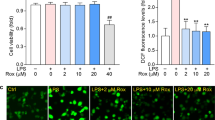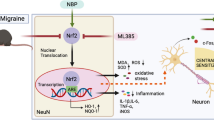Abstract
Migraine causes severe health and social issues worldwide. Rhynchophylline (Rhy) is one of the major active components of Uncaria rhynchophylla that is used for the treatment of headache in Traditional Chinese Medicine. In the current study, the effect of Rhy on nitroglycerin (NTG)-induced migraine was assessed and the associated mechanism was also explored to explain its function. Rats were pre-treated with Rhy of two doses (10 mg/kg and 30 mg/kg) and then subjected to NTG to induce migraine symptoms. Thereafter, the electroencephalogram (EEG) signaling, spontaneous behaviors, levels of indicators related to oxidative stress, and expression of calcitonin gene-related peptide (CGRP) were measured to assess the anti-migraine function of Rhy. Moreover, the activities of MAPK/NF-κB pathway under the administrations of Rhy were also detected. The results showed that NTG induced EEG and behavior disorders in rats, which was associated with the initiation of oxidative stress and increased expression of CGRP. Nevertheless, the pre-treatments with Rhy attenuated the damages induced by NTG by reversing the levels of all the above indicators. The results of western blotting demonstrated that the anti-migraine effect of Rhy was accompanied by the inhibition of MAPK/NF-кB pathway. The findings outlined in the current study revealed an alternative mechanism of Rhy in protecting brain tissues against migraine: the agent exerted its effect by suppressing MAPK/NF-кB pathway, which would ameliorate impairments associated with migraine.





Similar content being viewed by others
Change history
29 January 2024
This article has been retracted. Please see the Retraction Notice for more detail: https://doi.org/10.1007/s11010-024-04941-1
References
Welch KMA, Goadsby PJ (2002) Chronic daily headache: nosology and pathophysiology. Curr Opin Neurol 15(3):287–295
Schürks M, Diener HC, Goadsby P (2008) Update on the prophylaxis of migraine. Curr Treat Option Neurol 10(1):20–29
Weatherall MW (2015) The diagnosis and treatment of chronic migraine. Ther Adv Chronic Dis 6(3):115
Olesen J (2008) The role of nitric oxide (NO) in migraine, tension-type headache and cluster headache. Pharmacol Ther 120(2):157–171
Yin M-F, Lian L-H, Piao D-M, Nan J-X (2007) Tetrandrine stimulates the apoptosis of hepatic stellate cells and ameliorates development of fibrosis in a thioacetamide rat model. World J Gastroenterol 13(8):1214
Qin G, Fan X, Chen L, Shen C, Gui B, Tan G, Zhou J (2012) Preventive effects of AdR-siPTEN through the regulation of NMDA receptor NR2B subunit in trigeminal ganglia of migraine rats. Neurol Res 34(10):998–1006
Liang X, Wang S, Qin G, Xie J, Tan G, Zhou J, McBride DW, Chen L (2017) Tyrosine phosphorylation of NR2B contributes to chronic migraines via increased expression of CGRP in rats. Biomed Res Int. https://doi.org/10.1155/2017/7203458
Neeb L, Reuter U (2007) Nitric oxide in migraine. CNS Neurol Disord Drug Targets 6(4):258–264
Pardutz A, Hoyk Z, Varga HL, Schoenen J (2010) Oestrogen-modulated increase of calmodulin-dependent protein kinase II (CamKII) in rat spinal trigeminal nucleus after systemic nitroglycerin. Cephalalgia 27(1):46–53
Varga H, Pardutz AE, Bohar Z, Bago F, Tajti J, Bari F, Vecsei L (2009) Selective inhibition of cyclooxygenase-2 attenuates nitroglycerin-induced calmodulin-dependent protein kinase II alpha in rat trigeminal nucleus caudalis. Neurosci Lett 451(2):170–173
Reuter U, Bolay H, Jansen-Olesen I, Chiarugi A, Rio MSD, Letourneau R, Theoharides TC, Waeber C, Moskowitz MA (2001) Delayed inflammation in rat meninges: implications for migraine pathophysiology. Brain 124(Pt 12):2490
Li Y, Zhang Q, Qi D, Li Z, Yi L, Li Q, Zhang Z (2016) Valproate ameliorates nitroglycerin-induced migraine in trigeminal nucleus caudalis in rats through inhibition of NF-кB. J Headache Pain 17(1):1–9
Shi JS, Yu J-X, Chen XP, Xu RX (2003) Pharmacological actions of Uncaria alkaloids, rhynchophylline and isorhynchophylline. Acta Pharmacol Sin 24(2):97
Zhou J, Zhou S (2010) Antihypertensive and neuroprotective activities of rhynchophylline: the role of rhynchophylline in neurotransmission and ion channel activity. J Ethnopharmacol 132(1):15–27
Cao W, Wang Y, Lv X, Yu X, Li X, Li H, Lu D, Qi R, Wang H (2012) Rhynchophylline prevents cardiac dysfunction and improves survival in lipopolysaccharide-challenged mice via suppressing macrophage I-kappaBalpha phosphorylation. Int Immunopharmacol 14(3):243–251
Song Y, Qu R, Zhu S, Zhang R, Ma S (2012) Rhynchophylline attenuates LPS-induced pro-inflammatory responses through down-regulation of MAPK/NF-κB signaling pathways in primary microglia. Phytother Res 26(10):1528–1533
Hsieh CL, Ho TY, Su SY, Lo WY, Liu CH, Tang NY (2009) Uncaria rhynchophylla and rhynchophylline inhibit c-Jun N-terminal kinase phosphorylation and nuclear factor-κB activity in kainic acid-treated rats. Am J Chin Med 37(02):351–360
Huang H, Zhong R, Xia Z, Song J, Feng L (2014) Neuroprotective effects of rhynchophylline against ischemic brain injury via regulation of the Akt/mTOR and TLRs signaling pathways. Molecules 19(8):11196–11210
Wang M, Li H, Zhao Y, Lv C, Zhou G (2019) Rhynchophylline attenuates allergic bronchial asthma by inhibiting transforming growth factor-beta1-mediated Smad and mitogen-activated protein kinase signaling transductions in vivo and in vitro. Exp Ther Med 17(1):251–259
Baeuerle PA, Baltimore D (1996) NF-kappa B: ten years after. Cell 87(1):13–20
Dai J-N, Zong Y, Zhong L-M, Li Y-M, Zhnag W, Bian L-G, Ai Q-L, Liu Y-D, Sun J, Lu D (2011) Gastrodin inhibits expression of inducible NO synthase, cyclooxygenase-2 and proinflammatory cytokines in cultured LPS-stimulated microglia via MAPK pathways. PLoS ONE 6(7):e21891
Fehrenbacher JC, Taylor CP, Vasko MR (2003) Pregabalin and gabapentin reduce release of substance P and CGRP from rat spinal tissues only after inflammation or activation of protein kinase C. Pain 105(1):133–141
Taylor CP, Angelotti T, Fauman E (2007) Pharmacology and mechanism of action of pregabalin: the calcium channel α 2-δ (alpha 2-delta) subunit as a target for antiepileptic drug discovery. Epilepsy Res 73(2):137–150
Macdonald RL, Olsen RW (1994) GABAA receptor channels. Annu Rev Neurosci 17(1):569
Ilknur E, Füsun A, Derya A, Ersin O (2010) Increased vulnerability to oxidative stress in pediatric migraine patients. Pediatr Neurol 43(1):21–24
Yin Z, Fang Y, Ren L, Wang X, Zhang A, Lin J, Li X (2009) Atorvastatin attenuates NF-κB activation in trigeminal nucleus caudalis in a rat model of migraine. Neurosci Lett 465(1):61–65
Uwe R, Alberto C, Hayrunnisa B, Moskowitz MA (2010) Nuclear factor-kappaB as a molecular target for migraine therapy. Ann Neurol 43(4):426–427
Acknowledgements
This study was supported by Fujian Health and Family Planning Youth Research Project (No. 2016-2-66).
Author information
Authors and Affiliations
Corresponding authors
Ethics declarations
Conflict of interests
The authors disclose no conflict of interests.
Additional information
Publisher's Note
Springer Nature remains neutral with regard to jurisdictional claims in published maps and institutional affiliations.
This article has been retracted. Please see the retraction notice for more detail: https://doi.org/10.1007/s11010-024-04941-1
Rights and permissions
Springer Nature or its licensor (e.g. a society or other partner) holds exclusive rights to this article under a publishing agreement with the author(s) or other rightsholder(s); author self-archiving of the accepted manuscript version of this article is solely governed by the terms of such publishing agreement and applicable law.
About this article
Cite this article
Lai, T., Chen, L., Chen, X. et al. RETRACTED ARTICLE: Rhynchophylline attenuates migraine in trigeminal nucleus caudalis in nitroglycerin-induced rat model by inhibiting MAPK/NF-кB signaling. Mol Cell Biochem 461, 205–212 (2019). https://doi.org/10.1007/s11010-019-03603-x
Received:
Accepted:
Published:
Issue Date:
DOI: https://doi.org/10.1007/s11010-019-03603-x




